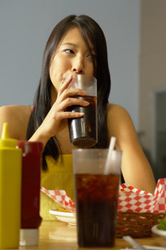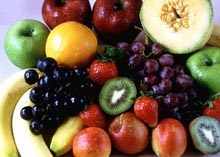Soda’s Surprisingly Serious Impact on Your Muscles:
Why You May Want to Kick Your Soda Habit for Good
by www.SixWise.com
Do you drink a lot of soda? There’s more to think about than just the sugar, caffeine and extra calories … a new study found it might do serious damage to your muscles as well.
|

The glucose, fructose and caffeine in soda may be causing low potassium levels in Americans, and leading to potentially serious muscle weakness.
|
Hypokalemia (low potassium levels) can result in minor symptoms such as muscle weakness, muscle aches and muscle cramps, or in more severe cases arrhythmia (irregular heartbeat) and paralysis. The recent study involved people who drank between two to nine liters of soda a day and found they exhibited symptoms of cola-induced hypokalemia.
Two of the study participants were also pregnant and admitted to a hospital due to their low potassium levels:
-
A 21-year-old pregnant woman who drank up to three liters of cola a day experienced fatigue, weight loss and persistent vomiting. An EKG showed heart blockage and a blood test confirmed low potassium levels.
-
A pregnant woman who drank up to seven liters of cola daily for 10 months also had low potassium levels and experienced worsening muscle weakness.
After being administered intravenous potassium and eliminating cola from their diet, both patients made a full recovery.
“We are consuming more soft drinks than ever before, and a number of health issues have already been identified including tooth problems, bone demineralization and the development of metabolic syndrome and diabetes,” said Dr. Moses Elisaf of the University of Ioannina in a HealthDay article. “There’s increasing evidence that excessive cola consumption leads to hypokalemia.”
Elisaf cited the main ingredients in cola, glucose, fructose and caffeine, as the main culprits to hypokalemia, with caffeine intoxication as the leading contributor.
|

Your body absorbs potassium naturally through dietary intake, so if you drink a lot of soda or think you may be low in potassium make sure to eat a lot of potassium-rich foods such as:
- Fresh fruits: bananas, cantaloupe, oranges, strawberries, kiwi, avocados and apricots
- Fresh vegetables: greens, mushrooms, peas, beets and tomatoes
- Meats: beef, fish and turkey
- Natural juices: orange, prune, apricot and grapefruit
|
More Reasons to Avoid Soda -- the Often Overlooked Liquid Calorie
Researchers at Purdue University conducted a study a few years ago that gave the participants an extra 450 calories of sugar a day in the form of jellybeans and soda. The participants were required to consume their sugar choice every day and then on random days disclose to the researchers what else they ate on those particular days.
The results went far beyond the preference for jellybeans or soda. What it did reveal was that there was a natural tendency to reduce calorie intake for the day after eating the jellybeans and an increase in calories when the participants drank soda.
In other words, the participants didn’t perceive liquid calories the same as solid food calories, and therefore they didn’t feel the need to cut anything from their diet when drinking soda.
According to a 2007 study, beverages make up 21 percent of the American daily caloric intake. So this means it is very likely that many of us are unknowingly sipping an extra several hundred calories a day in sugary liquids!
“Sugar-sweetened beverages are far and away the largest contributor of beverage calories in the population,” said Richard Mattes, a professor of foods and nutrition at Purdue and co-author on the jellybean study from an article in The Bulletin. “If you had to intervene somewhere, then it’s a good place to start.”
Expert Frankie Mauti, a registered dietician at St. Charles Bend, agreed with Mattes. When counseling her patients the main thing she focuses on is what they are drinking.
“If they’re doing fruit juice in the morning or soda, I’ll say that’s an easy way to cut calories without affecting too much,” she told The Bulletin.
Empty Calories and Cheap Sweeteners
Soda has gotten a bad rap over the years and has picked up the blame for several health problems ranging from diabetes to tooth decay, hyperactivity and obesity.
The dangers of these sweetened beverages begin with the ingredients. For example, the average cola contains a mix of carbonated water, caramel color, natural flavors, caffeine, phosphoric acid and high-fructose corn syrup.
One of the worst ingredients in this list is high-fructose corn syrup, which provides practically no nutritional value, but contains an abundance of calories -- and may be even worse for you than sugar. Further, recent studies have found it is often contaminated with toxic mercury!
Phosphoric acid is another ingredient that keeps soda on the top of the unhealthiest beverage list. It is a chemical added to soda to give you that zing or sour flavor at the same time breaking down starches into sugar.
However, phosphoric acid and the caffeine that’s often in soda is a combination that could be bad for your bones. While caffeine can interfere with your body's ability to absorb calcium or increase the amount it gets rid of, the acids in soda can cause your body to become more acidic -- causing it to release even more calcium.
Kicking Your Soda Addiction
Statistics are showing that despite the negative health effects, consumption of sweetened beverages is on a steady incline. According to an article in the American Journal of Preventive Medicine, liquid calories consumed by Americans over the age of 2 made up 21 percent of the total daily calorie intake. And the number of sweetened soft drinks and fruit juice drinkers among Americans has tripled between 1977 and 2001.
Drinking 10 sodas a day has become second nature to people addicted to the sugar-sweetened taste and caffeine soda provides.
If you’re ready to give up experiencing low energy levels, fatigue and numerous future health problems and rid your diet of these unhealthy beverages you could start by trying these five steps.
-
Dedicate yourself to breaking your habit: By making a firm commitment to yourself to become soda-free, you’re more likely to keep it a personal goal and want to stick to it.
-
Don’t reach for a diet soda: They may be free of sugar, but also contain artificial sweeteners such aspartame and sucralose that can also become addicting and contain a myriad of health risks.
-
Wean yourself off soda by limiting your daily intake: Cutting back on your soda consumption a little each day will increase your odds of long-term success. You can try eliminating one can a day or switch to miniature cans of soda.
-
Identify your triggers: Be mindful of your weak moments such as when you’re tired or bored and fill those times with healthier alternatives such as going for a walk or grabbing a piece of fruit to fulfill your sugar need with natural sugar.
-
Start a journal: Log your daily soda intake and the times you feel the need for a quick caffeine, sugar fix. Think about how you are feeling during those times and write it down. By doing so you’ll become aware of when you are mindlessly reaching for a can of soda, determine your triggers and begin to steer clear of them.
Stock up on These Five Soda Alternatives
To help you resist the temptation to grab a can of soda, get rid of all your soda and instead have these healthy alternatives on hand.
- Turn plain old water into a fun drink: You can spruce up your water by adding some non-caloric additions like a sprig of mint, slice of lemon or cucumber, frozen strawberry or lime. The options are endless! Make these creative concoctions your new healthy habit.
- Go green: Several studies have shown the benefits of drinking green tea, including reducing the risk of cancer, heart disease, hypertension and kidney stones. You can enjoy this tasty drink hot or cold and caffeine-free too.
- Try a cup of chai tea: Opt for a 100 percent natural drink with no preservatives and no artificial flavors or colors with Ajmera Incredibles Xpress Chai Tea, available in three flavors, Spice, Cardamon and Plain. It’s creamy and delicious, and like its name implies, takes just an instant to make. The Chai packets are great for taking to work or when you’re in a hurry, as you simply add hot water and your cup of tasty chai is ready.
- Blend your own vegetable juice: Start off your day with high energy levels by blending your favorite vegetables in your juicer for a delicious, low-calorie drink.
- Put back the juice box and make your own juice spritzer: Soda and fruit juices contain many extra calories. You can mix your own juice spritzer by combining one or two parts seltzer, mineral water, or club soda with one part 100 percent fruit juice such as fresh-squeezed orange juice.
Recommended Reading
Glucose, Fructose and Sucrose: What’s the Difference Between These Sugars … and Which is the Worst for Your Health?
America's Consumption of Added Fats and Sugars Continues: How to Avoid it
Sources
International Journal of Clinical Practice June 2009; 63(6):900-2
HealthDay News May 27, 2009
MedicineNet.com
Your Total Health
WebMD.com
Journal of the American Medical Association January 21, 2009:301(3):318-20